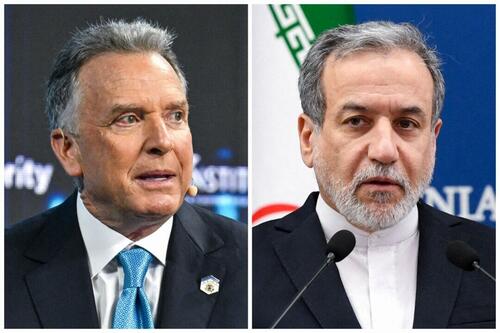Authored by Andrew Thornebrooke via The Epoch Times,
Iran and the United States have ended their second round of talks aimed at curbing Iran’s nuclear weapons development and agreed to hold a third next week.
Iran’s Foreign Minister Abbas Araghchi and presidential envoy Steve Witkoff held the second round of talks in Rome on April 19.
As with the first round of talks, which were held in the Omani capital of Muscat last week, the pair negotiated indirectly through an Omani official who shuttled messages between the two sides.
Witkoff and Araghchi interacted with one another briefly at the end of the first round of talks, but officials from the two countries have not held direct negotiations since 2015 under President Barack Obama.
The pair agreed on Saturday to meet again in Oman on April 26. Additional experts from both sides will also meet between now and that time, suggesting that there has been some movement in the second round of talks between the two countries.
The experts will discuss details of a possible deal on a technical level, according to Iran.
“The talks were held in a constructive environment and I can say that is moving forward,” Araghchi told Iranian state television. “I hope that we will be in a better position after the technical talks.”
The high-stakes talks largely hinge on Witkoff and Araghchi’s ability to find common ground on Iran’s nuclear program and regional security issues.
Araghchi said ahead of the talks that Tehran was committed to diplomacy and called on “all parties involved in the talks to seize the opportunity to reach a reasonable and logical nuclear deal.”
“Such an agreement should respect Iran’s legitimate rights and lead to the lifting of unjust sanctions on the country while addressing any doubts about its nuclear work,” Araghchi said, according to Iranian state media.
Tehran has sought to tamp down expectations of a quick deal, however, and Iranian Supreme Leader Ayatollah Ali Khamenei said this week he was “neither overly optimistic nor pessimistic” that a deal would be reached.
Iran’s Nuclear Weapons Capability in Focus
It is unclear what the current contours of negotiations hinge on. Iranian officials last week said the initial rounds of talks would be focused on laying out each party’s position and any red lines.
To that end, U.S. President Donald Trump has made preventing Tehran’s acquisition of a nuclear weapon a priority of his foreign policy platform. He appears willing to allow the Middle Eastern country to maintain its nuclear power facilities, provided its uranium enrichment is brought to lower thresholds.
“I’m for stopping Iran, very simply, from having a nuclear weapon,” Trump told reporters at the White House on Friday. “They can’t have a nuclear weapon. [But] I want Iran to be great and prosperous and terrific.”
Trump first sent a letter to Khamenei in March, suggesting a new deal to curb Iran’s nuclear program, which Tehran refused at the time.
Since then, Trump has doubled down on his stance that the United States “can’t let [Iran] have a nuclear weapon” and has threatened to use military action against Iran if a deal is not reached.
“If they don’t make a deal, there will be bombing, and it will be bombing the likes of which they have never seen before,” Trump wrote in a March 30 social media post.
Trump also restored a “maximum pressure” campaign on Tehran in February, reimposing sanctions on Tehran as part of the wider effort to push Iran to the negotiating table.
Tehran does not have nuclear weapons and has continued to enrich uranium at near weapons-grade levels since Trump unilaterally terminated a bilateral nuclear agreement in 2018 that had placed limits on such activities. At the time, Trump criticized the deal as “one of the worst and most one-sided transactions the United States has ever entered into” and said it “gave the Iranian regime too much in exchange for too little.”
A report by the United Nations’ nuclear watchdog released early in the year suggested that Iran had accelerated its production of near-weapons-grade uranium to such an extent that Tehran could likely produce about a half dozen warheads if it so chose.
Tehran maintains that its nuclear program is peaceful and that it is willing to negotiate some curbs in return for the lifting of sanctions, but wants watertight guarantees that Washington will not renege again.
46 Years of Enmity
Overcoming the historical enmity between Washington and Tehran is no easy feat. Relations between the two powers have been antagonistic for nearly half a century.
Iran was once one of the United States’ top allies in the Middle East. The Iranian monarchy purchased American-made weapons and was seen by U.S. leaders as an authoritarian but modernizing force that provided a bulwark against the spread of communism.
That relationship came to an end in 1979, when Iran’s last ruling monarch fled the nation amid popular uprisings, and power was seized by Islamist forces. Since that time, the Islamic Republic of Iran has opposed the secular modernism associated with the United States and called for the destruction of the nation of Israel.
Tensions between Washington and Tehran have reached a near breaking point in recent years, however, owing in part to Iran’s financial and military support of terror groups including Hamas in the Gaza Strip, Hezbollah in Lebanon, and the Houthis in Yemen.
Tehran has also signed extensive military technology agreements with Russia in recent years and conducted oil-for-services deals with China that skirt international sanctions. Though it is unclear to what extent, if any, those issues will weigh on current talks.
Loading…


















